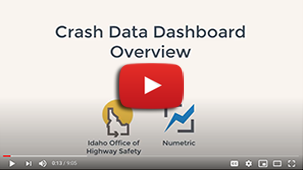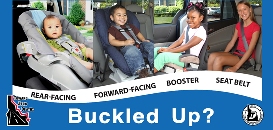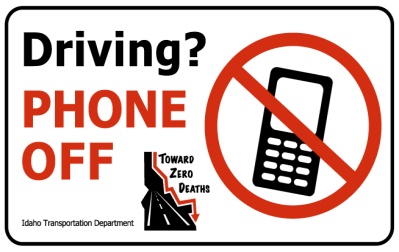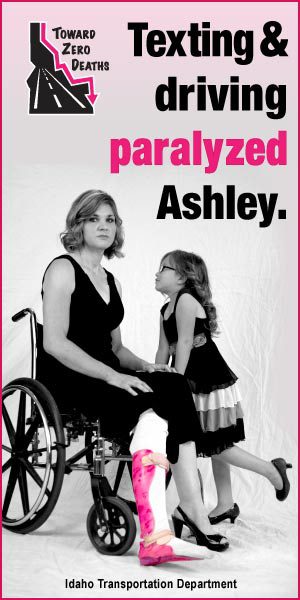Highway Safety
Crash Records & Statistics
Submit a Crash Report Request
Crash records are considered public information, and as such, are available to the general public. In accordance with Idaho Code, the Office of Highway Safety (OHS) charges for each copy of a crash report, if applicable.
- Crash report requests may be made online through ITD Forms – Crash Reports. The charge is $7.00 plus transaction fee.
- Statistical information not contained in the annual Idaho Traffic Crash Reports can also be obtained through the OHS, other charges may apply.
- For more information on Idaho’s crash reporting or electronic citation system eImpact, WebCARS or SWET (State-Wide Electronic Ticketing) application, please email: Brad.Biskup@itd.idaho.gov
Crash Data and Statistical Information
 Thousands of crashes happen each year on Idaho roads. Collection and analysis of crash reports is a crucial function of the Office of Highway Safety (OHS) to help make data-driven decisions that affect Idaho’s transportation system and the people who use it.
Thousands of crashes happen each year on Idaho roads. Collection and analysis of crash reports is a crucial function of the Office of Highway Safety (OHS) to help make data-driven decisions that affect Idaho’s transportation system and the people who use it.
A Vehicle Crash Report (VCR) is filled out for every crash that involves a motor vehicle, occurs on public property and results in more than $1500 ($750 before January 1, 2006) property damage for any one person involved in the crash, or results in an injury to any person involved. Law enforcement officers who respond to crashes identify a number of factors that contributed to the crash. These factors encompass all three aspects of the crash: environment (including location and road conditions), vehicle, and person information.
Once a crash report is completed, the responding law enforcement agency transmits the information to OHS electronically where the report is reviewed by a crash analyst. The crash analyst then checks the report for accuracy before entering the information into Idaho’s crash database.

The ITD Crash Data Dashboards are an online resource showing crash trends and data. The dashboard contains a series of dynamic charts, graphs, and maps. The dashboard allows users to apply their own filters to crash data for custom searches.
The OHS publishes the Traffic Crash Report for Idaho. This report tabulates, analyzes and summarizes the various aspects of traffic collisions. The report is divided into sections to better facilitate searches for specific information.
Idaho Traffic Crash Report 2024
- Entire report in PDF format
Idaho Traffic Crashes 2023 (Entire report in PDF format)
Fatality Information by ITD District 2019-2023 (Excel file)
Collision Report by Sections
- Executive Summary and Crash Clock
- Introduction, Explanation of Data, Glossary and References
- General Collision Statistics (Crashes, People Killed & Injured, Rates, Costs, Contributing Circumstances)
- Collisions by Roadway Classification
- Collision Statistics by County and City (Population > 5,000 People)
- Collisions by Time (Month, Day, Hour)
- Driver Collision Statistics (Age, Gender, Violations, License Suspensions)
- Collisions by Number of Units Involved (Single vs. Multiple Vehicle Crashes)
- Impaired Driving
- Safety Restraints
- Aggressive Driving
- Distracted Driving
- Youthful Drivers (Age 15-19) – Additional info under “Driver Collision Statistics”
- Emergency Medical Services
- Pedestrians, Bicyclists & Motorcycles
- Commercial Motor Vehicles
- Work Zone Collisions
- Appendix A: Maps of Fatal Collision Locations
- Appendix B: Map of Wild Animal Crashes
- Appendix C: State Highway Information
- Appendix D: 5-Year Collision Information
- Appendix E: 25-Year History – Fatalities & Fatality Rate
Idaho Traffic Crashes 2022 (Entire report in PDF format)
Fatality Information by ITD District 2018-2022 (Excel file)
Collision Report by Sections
- Executive Summary and Crash Clock
- Introduction, Explanation of Data, Glossary and References
- General Collision Statistics (Crashes, People Killed & Injured, Rates, Costs, Contributing Circumstances)
- Collisions by Roadway Classification
- Collision Statistics by County and City (Population > 5,000 People)
- Collisions by Time (Month, Day, Hour)
- Driver Collision Statistics (Age, Gender, Violations, License Suspensions)
- Collisions by Number of Units Involved (Single vs. Multiple Vehicle Crashes)
- Impaired Driving
- Safety Restraints
- Aggressive Driving
- Distracted Driving
- Youthful Drivers (Age 15-19) – Additional info under “Driver Collision Statistics”
- Emergency Medical Services
- Pedestrians, Bicyclists & Motorcycles
- Commercial Motor Vehicles
- Work Zone Collisions
- Appendix A: Maps of Fatal Collision Locations
- Appendix B: Map of Wild Animal Crashes
- Appendix C: State Highway Information
- Appendix D: 5-Year Collision Information
- Appendix E: 25-Year History – Fatalities & Fatality Rate
Idaho Traffic Crashes 2021 (Entire report in PDF format)
Fatality Information by ITD District 2017-2021 (Excel file)
Collision Report by Sections
- Executive Summary and Crash Clock
- Introduction, Explanation of Data, Glossary and References
- General Collision Statistics (Crashes, People Killed & Injured, Rates, Costs, Contributing Circumstances)
- Collisions by Roadway Classification
- Collision Statistics by County and City (Population > 5,000 People)
- Collisions by Time (Month, Day, Hour)
- Driver Collision Statistics (Age, Gender, Violations, License Suspensions)
- Collisions by Number of Units Involved (Single vs. Multiple Vehicle Crashes)
- Impaired Driving
- Safety Restraints
- Aggressive Driving
- Distracted Driving
- Youthful Drivers (Age 15-19) – Additional info under “Driver Collision Statistics”
- Emergency Medical Services
- Pedestrians, Bicyclists & Motorcycles
- Commercial Motor Vehicles
- Work Zone Collisions
- Appendix A: Maps of Fatal Collision Locations
- Appendix B: Map of Wild Animal Crashes
- Appendix C: State Highway Information
- Appendix D: 5-Year Collision Information
- Appendix E: 25-Year History – Fatalities & Fatality Rate
Idaho Traffic Crashes 2020 (Entire report in PDF format)
Fatality Information by ITD District 2015-2019 (Excel file)
Collision Report by Sections
- Executive Summary and Crash Clock
- Introduction, Explanation of Data, Glossary and References
- General Collision Statistics (Crashes, People Killed & Injured, Rates, Costs, Contributing Circumstances)
- Collisions by Roadway Classification
- Collision Statistics by County and City (Population > 5,000 People)
- Collisions by Time (Month, Day, Hour)
- Driver Collision Statistics (Age, Gender, Violations, License Suspensions)
- Collisions by Number of Units Involved (Single vs. Multiple Vehicle Crashes)
- Impaired Driving
- Safety Restraints
- Aggressive Driving
- Distracted Driving
- Youthful Drivers (Age 15-19) – Additional info under “Driver Collision Statistics”
- Emergency Medical Services
- Pedestrians, Bicyclists & Motorcycles
- Commercial Motor Vehicles
- Work Zone Collisions
- Appendix A: Maps of Fatal Collision Locations
- Appendix B: Map of Wild Animal Crashes
- Appendix C: State Highway Information
- Appendix D: 5-Year Collision Information
- Appendix E: 25-Year History – Fatalities & Fatality Rate
Child Safety Seat
Child Safety Information
Carma McKinnon is the statewide Child Passenger Safety Centralized Leadership coordinator. Carma works for the Lemhi County Sheriff’s Office in Salmon. If you need assistance regarding child passenger safety, don’t hesitate to contact Carma at -208-742-1683 or carma@lemhicountyidaho.org.
Rear Facing Seat
- To 2 years of age, or until the highest weight and height limit allowed by the car seat manufacturer.
Forward Facing Seat
- To upper height and weight limits of car seat, approximately 4 years and 40-65 pounds.
- The top tether should be used until child weighs 40 pounds.
Booster Seat
- From approximately 4 to at least 8 years old or 4’9”
- Use a high back or backless belt positioning booster
- Lap-belt only seating positions should not be used with booster seat
Adult Seat Belt
- Age 8 or older and at least 4’9”
- Lap belt lays across upper thighs and shoulder belt across chest; knees bend at seat edge
Car Seat Recommendations: Choosing the Right Seat
Child Restraint Basics – Pocket Card
The Children’s Hospital of Philadelphia (CHOP) created a pocket card which provides child restraint basic recommendations to parents and caregivers. The card features restraint types and positions based on a child’s height, weight and age. The card is free.
If you would like a card mailed to you, please contact:
Lisa Losness, Child Passenger Safety Program
ITD Office of Highway Safety
Phone: 208-334-8103
Lisa.Losness@itd.idaho.gov
- Espanol Recomendaciones de seguridad para el nino pasajero
- La Inspección del Asiento de Seguridad Para Niños
- WHALE brochure in Spanish
For more information on distribution points or to get a WHALE Kit, please contact:
Lisa Losness, Child Passenger Safety Program
ITD Office of Highway Safety
Phone: 208-334-8103
Lisa.Losness@itd.idaho.gov

Four Key Child Safety Steps
- Restrain children on every trip, every time.
- Keep children in the back seat until age 13.
- Use the correct safety seat for child’s size.
- Use child safety seats and seat belts correctly.
Child Safety Seat Ratings
The purpose of NHTSA’s ease of use rating program is to educate parents and caregivers about child safety seat features and which are easy to use.

Car Seat Registration
One of the most important goals for child passenger safety is to make sure that car seats and boosters meet all Federal Safety Standards. If it is determined that a car seat or booster doesn’t comply with the required safety standards, a recall may occur so that the manufacturer can fix the problem. Registering your seat makes sense because it gives the manufacturer the ability to contact you about recalls and safety notices.
Used Child Safety Seats
Don’t buy or sell used car seats. Although it is nice to share and reuse baby items, car seats are one product that shouldn’t be reused. The components used in the typical car seat deteriorate and weaken over time. Car seats have an expiration date stamped on the back of the seat; the expiration date is typically six years from the seat’s manufacture date. Click here for details on retiring a car seat.
The above information provided courtesy of consumer reports – Consumer Reports is published by Consumers Union. Both Consumer Reports and Consumers Union are not-for-profit organizations that accept no advertising. Neither has any commercial relationship with any advertiser or sponsor on this site.

• Click here to find locations for Car Seat Inspection sites in your area.
If no sites are available, contact Carma McKinnon at carma@lemhicountyidaho.org or 208-742-1683.
It is important to read and clearly understand all safety and booster seat installation and use instructions. Having your child safety seat initially checked and re-checked often by a trained professional increases your child’s chances of escaping injury in the event of a car crash.
![]()
Become a Technician
Child Passenger Safety Technicians train properly fit child safety seats. Out of the thousands of child safety seats installed in vehicles over 80% of them are incorrectly installed according to National surveys conducted by NHTSA (National Highway Traffic Safety Administration). The NHTSA Standardized Child Passenger Safety Training course is designed to certify child safety advocates as Child Passenger Safety Technicians. The course provides attendee’s with the knowledge and skills necessary to provide parents with accurate and consistent information regarding child car safety seats.
The Idaho Office of Traffic and Highway Safety recommends that anyone providing parent technical information regarding their child’s car seat should attend this valuable training course. The Idaho CPS program provides free Child Passenger Safety Inspection Stations through our hospitals, fire departments, police departments, and District Public Health Department offices. At these locations parents and caregivers can learn how to safely transport children by using the properly fitted child safety seats.
If you wish to take this course, you must register online at the National SAFE KIDS. This site describes policies and administrative requirements for course registration and certification for the National Standardized Child Passenger Safety Training Program. For those contemplating taking the course, please keep in mind that this is not an easy course and is physically exerting. It is a full 3 or 4 day course with a child safety seat check, hands on skills and Checks for Understanding that must be passed. It also requires the physical ability to climb in and out of cars, placing pressure on car seats to install them properly. It is not recommended for persons with back problems to take this course. To register you will need to be prepared to use a credit card to charge your registration fee of $95.00. This registration fee includes your manual and your 2-year NHTSA National Child Passenger Safety Certification. To remain current CPS technicians must recertify every 2 years.
If you have questions after you have read this page, or for details regarding course availability in Idaho, contact Carma McKinnon at 208-742-1683 or carma@lemhicountyidaho.org.

Emergency service personnel across Idaho have a tool available to help identify small children involved in motor vehicle crashes. The WHALE program “We Have A Little Emergency” gives instant identification of a child in a car safety seat in the event that an adult in the car is injured and unable to talk.
The WHALE identification card provides emergency personnel information to identify young children involved in a crash. Sometimes just knowing a child’s name can help rescue workers comfort young patients. Rescue workers can refer to an identification card attached to the safety seat and find the child’s name, medical information and who to contact in case of emergency. Stickers affixed to car windows and the safety seat also alert emergency workers that the child’s information is close at hand.
- WHALE brochure in English
- The “We Have A Little Emergency” (WHALE) brochure has been translated to Spanish.
- WHALE brochure in Spanish
The WHALE Kit includes:
- An Identification Card — containing a space for a photograph of the child, and important information about the child in the safety seat, such as the child’s name, date of birth, pertinent medical information, and whom to contact in an emergency.
- Two WHALE (seat) Stickers — the WHALE logo, to be attached to each side of the child safety seat.
- Two WHALE (window) Stickers — featuring the WHALE logo, to be attached to the lower rear corner of the vehicle’s windows.
For more information on distribution points or to get a WHALE Kit in English or Spanish, please contact:
Lisa Losness, Child Passenger Safety Program
ITD Office of Highway Safety
Phone: 208-334-8103
Lisa.Losness@itd.idaho.gov
Idaho’s Child Restraint Law
Idaho’s child passenger safety law requires all children 6 years of age or younger be properly restrained in an appropriate child safety restraint. This is a primary law, and current infraction penalties and fees may be reviewed on the Idaho Supreme Court’s website Infraction Penalty Schedule.
Child Passenger Safety Laws in Other States
If you happen to be travelling in other states, please be aware that other state laws differ from Idaho’s. All 50 states, the District of Columbia, Guam, the Northern Mariana Islands and the Virgin Islands require child safety seats for infants and children fitting specific criteria. Click here for other states’ laws pertaining to child passenger safety.
Partners for Child Passenger Safety
- Children’s Hospital of Philadelphia www.chop.edu/centers-programs/car-seat-safety-kids
- Safe Kids Worldwide www.safekids.org
- Idaho Chapter of American Academy of Pediatrics www.idahoaap.org
- Car Seat Blog carseatblog.com
- Child Care Aware www.childcareaware.org
- National Highway Traffic Safety Administration (NHTSA) Child Safety
- National Highway Traffic Safety Administration (NHTSA) Car Seats and Booster Seats
- Carma McKinnon, CPS Coordinator: carma@lemhicountyidaho.org
Lisa Losness, Child Passenger Safety Program
ITD Office of Highway Safety
Phone: 208-334-8103
Lisa.Losness@itd.idaho.gov
Aggressive Driving

Aggressive driving is a high-risk behavior. High-risk drivers climb into the anonymity of an automobile and take out their frustrations on anybody at any time. For them, frustration levels are high, and level of concern for fellow motorists is low. Most people believe that the worst thing that can happen if they speed or fail to obey traffic signals is that they will get a ticket, so it’s an acceptable risk. Drivers like this are wrong. Maybe even dead wrong, because aggressive driving can kill.
For more information on aggressive driving, visit shift-idaho.org/aggressive-driving
You are an aggressive driver if you:
- Ignore traffic signals
- Speed and tailgate
- Drive too fast for conditions
- Weave in and out of traffic
- Make improper lane changes frequently and abruptly
- Pass on the shoulder
- Make hand and facial gestures
- Scream, honk and flash lights
If confronted by an aggressive driver, you should:
- Get out of their way as soon as you can safely
- Stay calm – reaching your destination safely is your goal
- Do not challenge them
- Avoid eye contact
- Ignore gestures and don’t return them
- Report aggressive driving (vehicle description, license number, location)
- Always buckle up in case abrupt movements cause you to lose control of your vehicle
- If it leads to deliberate acts of violence this is Road Rage, which is a criminal act
Report Aggressive Drivers:
- Find a safe place to call 911
- Be prepared to provide location, vehicle description and license plate.
- Report an Aggressive Driver
Road Rage:
Road rage is a serious offense, and occurrences are becoming more common. Road rage is defined as a deliberate, violent act against another driver and is a criminal offense.
For more information about Aggressive Driving education and safety awareness efforts in Idaho please contact:
Josephine Middleton | Email: Josephine.Middleton@itd.idaho.gov
Distracted Driving

Distraction is defined by NHTSA as a specific type of inattention that occurs when drivers divert their attention away from the task of driving to focus on another activity instead. These distractions can be electronic distractions, such as navigation systems and cell phones, or more conventional distractions, such as interacting with passengers and eating. These distracting tasks can affect drivers in different ways and are categorized into the following three types:
- Visual – taking your eyes off the road;
- Manual – taking your hands off the wheel; and
- Cognitive – taking your mind off the road.
For more information visit shift-idaho.org
Research conducted by the Virginia Tech Transportation Institute (VTTI) in 2006 reported that, “Nearly 80% of crashes and 65% of near-crashes involved some form of driver inattention within three seconds before the event. The primary cause of driver inattention in this major study included such distracting activities as cell phone use and factors that significantly increase risk such as reaching for a moving object (a 9 times greater risk) and drowsiness (4 times greater).” Distracted driving caused by the use of a cell phone or any other electronic device to make a phone call, text a message, read email messages, manipulate music files or search for direction information is an ever growing concern.
Distracted Driving is a focus area in the Idaho Transportation Department’s Strategic Highway Safety Plan.
Below are links to sample distracted driving programs for your employees.
- Occupational Safety and Health Organization (OSHA)
- National Safety Council (NSC) – Employer tool kit for distracted driving
 Idaho Resources
Idaho Resources
- Television PSA’s are available at the following Idaho Transportation Department (ITD) YouTube page under Highway Safety Messages: https://www.youtube.com/user/idahoitd
- Posters and other items available through the following “Educational Materials Order Form” link: https://apps.itd.idaho.gov/Apps/EducationalMaterialOrderForm/
- “Your Text Can Wait” Public Service Announcement – https://www.youtube.com/watch?v=KvqF_bHdar0&list=UUULOgd2FNzmWtXfGeb-3vlA
- Focus on the Drive – http://justfocusonthedrive.com/
- Distracted Driving Task Force
National Resources
- NHTSA’s page for distracted driving: https://www.nhtsa.gov/risky-driving/distracted-driving
- GHSA (Governors Highway Safety Association) – texting laws http://www.ghsa.org/html/stateinfo/laws/cellphone_laws.html
- Utah – ZERO Fatalities, A Goal We Can All Live With – Texting and Driving Destroys Lives video http://www.zerofatalities.com/
- TxtResponsibly.org, raise awareness for the dangers of texting and driving – http://txtresponsibly.org/
- Hands-Free Info – reduce the confusion over local laws, http://handsfreeinfo.com
In an effort to provide materials for outreach and education, and to help raise awareness about the dangers of distracted driving, the Distracted Driving Task Force generated a toolkit of information for public use and mass distribution.
To get involved, please use the following toolkit information to help promote attentive driving for life:
Crash Information and Statistics
TEMPLATES
Employer Policies
Newsletters
Presentations
- Invite
- PowerPoint
- Thank You
- For a list of presenters, email Josephine.Middleton@itd.idaho.gov
Press Releases
Seat Belts
Buckle Up, Idaho Campaign
SHIFT | Drive Well Idaho
Learn more about Idaho’s effort to SHIFT behaviors and emphasize engaged driving @ shift-idaho.org
Join the Conversation
Seat Belt Surveys
The Office of Highway Safety conducts observational seat belt surveys every year. The surveys are conducted at 100 sites throughout the state. The surveys are used to estimate seat belt usage throughout the state. Blank pages have been removed from the documents.
- 2024 Observational Survey
- 2023 Observational Survey
- 2022 Observational Survey
- 2021 Observational Survey
- 2019 Observational Survey

Idaho’s Seat Belt Law: Idaho Code 49-673
Idaho law requires everyone in a vehicle to wear safety restraints. Other provisions under the law include:
- Adult violators, 18 and older, are subject to a $10 citation.
- An adult driver is ticketed for passengers younger than 18 who are not properly restrained.
- If the driver is younger than 18 and the driver or any occupant younger than 18 fails to wear a seat belt, court costs are added to the fine. Current infraction penalties and fees may be reviewed on the Idaho Supreme Court’s website, specific link: Infraction Penalty Schedule
- A law enforcement officer can issue a citation solely for a safety restraint violation, but there must be another violation leading to the traffic stop.
Youth Education
The Office of Highway Safety produces educational materials which are available at no cost to qualified organizations for distribution to the general public. Typically, the materials are made available to law enforcement agencies, government and non-profit organizations.
- Pedestrian Law
- Pedestrian Safety Fun Page
- Walk Smart
- Bicycle Law
- Bicycle Safety Fun Page
- Seat Belt Fun Page
Teen Driving

Serious and, often times, fatal crashes are the result of distracted driving. Anytime you take your eyes off the road, your hands off the steering wheel, and/or take your mind off driving, you become a distracted driver.
Resist the urge to text, talk on a cell phone, eat or drink while driving.
Resource
- NHTSA Teen Driving Website
- Idaho High School Distracted Driving Program
- National Organizations for Youth Safety (NOYS) – http://www.noys.org
- responsibility.org
What are Local Teens Doing?
Youth all over the state are doing wonderful things to get the word out about distracted driving. Did your school create a message to teens about the dangers of texting and driving or distracted driving. If so, tell us about it. We’d love to share it with other teens around the state. Send us a link to your YouTube video, the PSA, or a .jpg of the artwork to: ohsweb@itd.idaho.gov
Grant Programs & Funding
The ITD Office of Highway Safety (OHS) provides grant funding for efforts addressing specific behavior-related traffic safety priority areas. These include: Impaired Driving, Aggressive Driving, Distracted Driving, Occupant Protection, Bicycle, Pedestrian, Motorcycle Safety, Youthful Drivers, and Traffic Records. Grants may be awarded for assisting OHS in targeting traffic safety deficiencies, expansion of an ongoing activity, or development of a new program or intervention.
- Grant Procedure Manual – For complete descriptions and procedures in conducting a grant through the Office of Highway Safety.
FY26 Traffic Enforcement Grant Project Agreement
Includes Mini Grants, Mobilization Requests
By submitting the following documents to the Office of Highway Safety, your agency may participate in the FY26 High Visibility Enforcement mobilizations, apply for mini-grant funding and E-citation equipment.
- Traffic Enforcement Grant Project Agreement
- Certifications and Assurances
- Financial Risk Assessment
- TEGPA Instructions
For questions, contact: Madeleine.Fletcher@itd.idaho.gov or 208-334-8104
FY27 Grants: Oct. 1, 2026 – Sept. 30, 2027
The Office of Highway Safety will open the application period in December 2025 – February 2026
In order to receive the Federal highway safety funding, each State must submit a High Safety Plan, which includes a description of the processes used by the State to identify its highway safety problems, define its highway safety performance measures, set goals for those performance measures, and develop projects and activities to address its problems and achieve its goals. The Plan, approved by the Governor’s Representative for Highway Safety, must also include descriptions of the projects and activities the State plans to implement and link the countermeasure strategies and projects to the goals identified in the Plan.
- FFY 2024-2026 Triennial Highway Safety Plan
- FFY 2023 Highway Safety Plan
- FFY 2022 Highway Safety Plan
- FFY 2021 Highway Safety Plan
- FFY 2020 Highway Safety Plan
- FFY 2019 Highway Safety Plan
Each State is also required to submit an Annual Report within 90 days of the end of the Federal Fiscal Year which evaluates the State’s progress in meeting its highway safety goals, using performance measures identified in the Highway Safety Plan and describes how the projects and activities funded during the fiscal year contributed to meeting the State’s highway safety goals.
- FFY 2022 Annual Report
- FFY 2021 Annual Report
- FFY 2020 Annual Report
- FFY 2019 Annual Report
- FFY 2018 Annual Report
A “traffic safety problem” is an identifiable subgroup of drivers, pedestrians, vehicles, or roadways that is statistically higher in collision experience than normal expectations. Problem identification involves the study of relationships between collisions and the population, licensed drivers, registered vehicles, and vehicle miles traveled, as well as characteristics of specific subgroups that may contribute to collisions.
The process used to identify traffic safety problems began initially by evaluating Idaho’s experience in each of the National Highway Traffic Safety Administration’s (NHTSA’s) eight highway safety priority areas. These were program areas determined by NHTSA to be most effective in reducing motor vehicle collisions, injuries and deaths. Consideration for other potential traffic safety problem areas came from analyzing Idaho collision data, suggestions from Idaho Traffic Safety Commission (ITSC) members, suggestions by Office of Highway Safety staff, and by researching issues identified by other states. All traffic safety problems must be validated with supporting data and there must be an effective countermeasure to address the problem that is eligible for Federal highway safety funds.
The traffic safety problem areas that have been identified and are currently being addressed are: Aggressive Driving, Occupant Protection, Impaired Driving, Distracted Driving, Youthful Drivers, Pedestrian Safety, Bicycle Safety, Motorcycle Safety, Traffic Records, and Emergency Medical Services.
Forms & Resources
- Revised Quarterly Performance Report for Year-Long Grants – Grant activity and evaluation form (Word format)
- Strategic Highway Safety Plan (SHSP)
- Federal Fiscal Year 2024 Public Engagement Tracking Sheet (Excel)
An ignition interlock is an instrument designed to measure the BAC (breath alcohol concentration) of an individual, equipped with a camera and prevents a motorized vehicle from starting when the BAC is greater than or equal to .025.
The ignition interlock manufacturers on the Ignition Interlock Providers List have to be certified by the Idaho Transportation Department (ITD) to meet the standards set forth by the National Highway Traffic Safety Administration (NHTSA) for model specification for breath alcohol ignition interlock devices (BAIIDS).
If you are required to have an ignition interlock installed it is your responsibility to contact the companies listed to determine the nearest service center, cost, availability and appointment requirements.
The ITD does not install ignition interlocks, cannot recommend a company or provide the nearest installation center.
For question regarding ignition interlocks call the ITD Driver Services at 208-334-8000.
Idaho Statutes concerning Traffic Records and Highway Safety
All Idaho Statutes
- Traffic Records (Motor Vehicle Crashes) 49-1301 to 49-1316
- Driving Under the Influence (Testing, Penalties, Ignition Interlocks) 18-8001 to 18-8011
- Texting While Driving 49-1401A
- Open Container Law 23-505
- Seat Belt Law 49-673
- Child Safety Seat Law 49-672
- Motorcycle Helmet Law 49-666
- Motorcycle Endorsement Law 49-304
- Graduated Licensing Law 49-307
- Pedestrian & Bicycles Laws 49-701 to 49-724
National Highway Traffic Safety Administration (NHTSA)
- Governors Highway Safety Association (GHSA)
- Federal Highway Administration (FHWA)
- Federal Motor Carrier Safety Administration (FMCSA)
- Bureau Of Transportation Statistics
- AAA Foundation for Traffic Safety
- Insurance Institute for Highway Safety
- Advocates for Highway and Auto Safety
- Network of Employers for Traffic Safety (NETS)
- SafetyBeltSafe U.S.A.
- Mothers Against Drunk Driving | MADD
- Motorcycle Safety | NHTSA
- Operation Lifesaver
Contacts

Office of Highway Safety (OHS)
Our Responsibilities: The primary responsibilities of the Office of Highway Safety are housing and maintaining the Statewide Collision Database, analyzing and disseminating collision statistics, and administering the federal section 402 highway safety funds.
Where we are located: The Office of Highway Safety is located in Boise, Idaho at the Idaho Transportation Department (ITD) headquarters complex. The Office of Highway Safety is located in the East Annex building.
The physical address is: 3293 W. Jordan Street, Boise, Idaho 83703
The mailing address is: Idaho Transportation Department-Office of Highway Safety | PO Box 7129 Boise, ID 83707-1129
Phone: 208-334-8100 | Fax: 208-334-4430
How we fit in: The Office of Highway Safety is under the Division of Engineering Products and Plans (DEPP) of the Idaho Transportation Department and works closely with other Department sections and districts to promote safe driving behaviors and improve the safety of roadways on the state highway system.
The Director of the Idaho Transportation Department serves as the Governors highway safety representative. The Office of Highway Safety is managed by the Highway Safety Manager. The Office of Highway Safety consists of two teams: the records team and the programs team. The records team is responsible for maintaining, updating, and ensuring the quality of the statewide motor vehicle crash database. The program team is responsible for administering Idaho’s Federal highway safety funds and analyzing and disseminating the crash data. All funding is subject to approval by the Idaho Traffic Safety Commission and the Idaho Transportation Board.
You can reach the Highway Safety section at 208-334-8000 or FAX 208-334-4430, or directly contact the staff below.
- Josephine Middleton, Highway Safety Manager | Phone: 208-334-8112 | E-mail: Josephine.Middleton@itd.idaho.gov
- For all non-emergency calls related to road hazards, please contact State Communications at 1-888-575-2666 or 911.
- To report unsafe driving, call 1-888-575-2666 or 911. Be prepared to provide location, vehicle description and license plate.
- For infrastructure safety concerns, please contact your local ITD District office.
Programs Team:
- Lisa Losness, Grants Contracts Officer for Impaired Driving, Vulnerable Users (Youth), Highway Safety Planning & Child Passenger
- Phone: 208-334-8103 | E-mail: Lisa.Losness@itd.idaho.gov
- Bill Kotowski, Grants Contracts Officer for Community Traffic Safety (Law Enforcement Liaisons, Coalition, Summit) & Public Outreach
- Phone: 208-334-8690 | E-mail: Bill.Kotowski@itd.idaho.gov
- Tabitha Smith, Grants Contracts Officer for Youthful Drivers, Distracted Driving, Alive at 25 & Occupant Protection
- Phone: 208-334-8104 | E-mail: Tabitha.Smith@itd.idaho.gov
- Denise Dinnauer, Grants Contracts Officer for Year-long Grants, Police Traffic Services, Compliance & Training
- Phone: 208-334-4460 | E-mail: Denise.Dinnauer@itd.idaho.gov
- Jillian Garrigues, Grants Contracts Officer for Motorcycles, Vulnerable Users (Bicycle & Pedestrian)
- Phone: 208-334-8557 | E-mail: jillian.garrigues@itd.idaho.gov
Records Team & Data Analysis:
- Steve Rich, Research Analyst Principal Behavioral Data Analysis & Dissemination
- Phone: 208-334-8116 | E-mail: Steve.Rich@itd.idaho.gov
- Kelly Campbell, Research Analyst Principal Location Data Analysis & Dissemination, Safety Evaluations, HAL Program, Traffic Records, SWET
- Phone: 208-334-8105 | E-mail: Kelly.Campbell@itd.idaho.gov
- Kirstin Weldin, Law Enforcement Trainer | E-mail: Kirstin.Weldin@itd.idaho.gov
- Carrie Akers, FARS Analyst | E-mail: Carrie.Akers@itd.idaho.gov
- David Prosser, Crash Data Records Specialist | E-mail: David.Prosser@itd.idaho.gov
- Julie Whistler, Crash Data Records Specialist | E-mail: Julie.Whistler@itd.idaho.gov
- Leslie De La Cruz, Crash Data Records Specialist | E-mail: Leslie.Cruz@itd.idaho.gov
- Madeleine Fletcher, Crash Data Records Specialist | E-mail: Madeleine.Fletcher@itd.idaho.gov
Mission Statement: We support the Department’s mission of ”Your Safety. Your Mobility. Your Economic Opportunity” by conducting programs to eliminate traffic deaths, serious injuries, and economic losses through funding programs and activities that promote safe travel on Idaho’s transportation systems, and collecting and maintaining crash data and utilizing reliable crash statistics.
Vision Statement: To be the best in the country in promoting safety on Idaho’s roads in an efficient and effective manner.
Operating Philosophy: The Office of Highway Safety has a deep concern for the welfare of the traveling public, and believe our main purpose is to save lives through creative, highly visible, innovative, and effective highway safety programs for all modes of transportation. We are committed to our critical role within the State of Idaho, and the rest of the nation, to ensure safe travel on Idaho’s roadways. As stewards, we have a responsibility to make a positive impact on peoples’ lives.
The continuation and expansion of state and local partnerships is essential to our success. The primary mission is to identify existing and emerging traffic safety trends through statistically-based problem identification efforts, to efficiently provide decision makers accurate data for use in determining where the most effective highway safety investment is made. This includes the task to develop and implement highway safety programs that save lives and prevent injuries, and to provide appropriate safety funds that empower communities to address critical local traffic safety issues.
As highway safety professionals, we are committed to teamwork, integrity and maintaining a positive working environment. In our highway safety partnerships, we respond, cooperate, and provide accurate and timely service. We are a leader in a coordinated statewide effort to eliminate death and serious injury on all of Idaho’s roadways.
Please send comments, questions and suggestions to: ohsweb@itd.idaho.gov
Or write to Idaho Transportation Department – Office of Highway Safety P.O. Box 7129 Boise, Idaho 83707-1129

